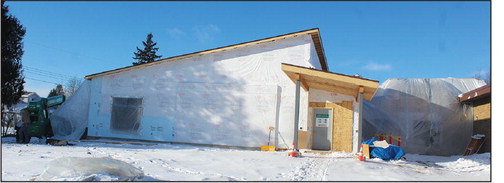Knowledge of technology helpful with virtual learning
The spring of 2020 presented quite an opportunity to expand classroom teaching into the virtual world. The 2020-21 school year finds teachers who are teaching students face-to-face and virtual at the same time. We have learned new technologies and techniques to better reach our students, but there are issues that present some challenges for our families and the IT department.
Many different terms are thrown out as an explanation for the problems as they arise. If you are not required to use a specific software or classroom platform on a regular basis, it is hard to understand exactly what it does. When students are learning from home parents, grandparents and other caregivers are also thrown into a sea of new terms. Let’s see if we can break it down a little: -- Google Classroom: Google Classroom is a learning management system where teachers can post class assignments for students to access their lessons. Students can also turn in their assignments through Google Classroom. Thinking back to when you were a student, teachers printed copies of assignments and distributed them in their classroom, other work was done through textbooks. Many of our current textbooks can be accessed online. While in Google Classroom, students can access an electronic copy of any handout. Students may fill these documents out online and turn them in to the teacher.
-- Webex: Students may receive an invitation in their email to join a Webex meeting. This link will allow them to attend a class via their computer while they are home. Students are able to ask questions and communicate in real time with the teacher and their peers.
-- Google Meet: This is another communication platform, like the Webex option. It is found in Google Classroom.
Here are some terms you may be hearing along with the definitions for your help.
1. Bandwidth: Bandwidth is the maximum data transfer rate of your network internet connection. This is a very important concept to understand if you have students working from home. Let’s compare bandwidth to electricity. When you have your coffee pot, electric frying pan, microwave and a Nesco roaster all plugged in at the same time, it is not a surprise when you blow a breaker. With experience, you learn how many appliances you can have running at the same time without the breaker kicking off. The more devices you have connected that are trying to collect or send data, the slower your connection will be across all of your devices.
2. Digital Subscriber Line (DSL – Frontier & TDS): DSL uses the existing telephone lines to transmit data, which are usually made of copper. DSL speed is dependent on how far it is between you and the next fiber connection.
3. Cable internet: Cable internet uses coaxial cable, also made from copper, and is generally bundled with the same cables used to run the television network. This is why many cable companies offer bundled plans with a TV subscription and internet access. The average speed for cable varies from around 20 Mbps to 100 Mbps. This is only available in the city limits.
4. Fiber Internet: Fiber internet is much faster than cable and can carry large amounts of data in a single line, often reaching multiple terabits of data transfer easily. A terabit is a multiple of the unit bit for digital information or computer storage. This is currently only available to large businesses due to the high cost.
5. LTE connection (Hotspots & Phones): LTE stands for Long Term Evolution. The goal of LTE was to increase the capacity and speed of wireless data networks using digital signal processing. This is when hotspots and cell phones are used for internet.
6. Device management: You may have great internet, but if you have multiple devices hooked up to your system, it doesn’t matter how great the internet is. We do need to be aware of other devices that are connected to your internet and are using resources.
1. TV - Smart televisions are everywhere. If you’re streaming Netflix, Hulu, Disney+ or any of the TV streaming services, you’re using bandwidth.
2. Gaming Consoles: Gaming consoles that are in rest mode automatically update and use up a huge amount of bandwidth.Playing online games uses up a lot of bandwidth.
3. Cell Phones : Cell phones that are connected to your wireless connection are collecting and sending data all the time.
4. Computers, tablets, etc.: Any device that is not turned off and is connected to the internet will use some bandwidth.
We’d like to share some of the providers in the Loyal School District area by type. These providers may or may not be available in all areas of our district. Please call the provider to check for availability of service at your address.
-- Wireless: Verizon, AT& T, Cellcom, Country Wireless, Sprint, U.S. Cellular are the most common wireless providers in our area. All wireless connections can be affected by trees, valleys, tower locations, weather, etc. which can affect overall speed and bandwidth.
-- Satellite: HughesNet, Skycasters & Viasat are satellite providers that are available almost anywhere, but service is very subject to trees and weather conditions. Due to latency, satellite is not good for video conferencing and multiple users.
-- Wired DSL Connections: Charter/Spectrum, Frontier & TDS. Wired Connections such as Charter, Frontier and TDS are limited to where you live. Charter is only available within the Loyal city limits. Frontier is available in the city limits and approximately four miles north, east and west of the city. TDS access is available in the western part of the Loyal School District. DSL connection is the best option as it provides higher bandwidth and lower latency internet connection. The downfall is that DSL is not available to all of our rural homes.


